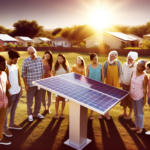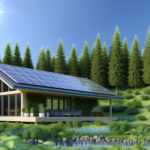Introduction
Overview of Solar Power
Solar power harnesses energy from the sun using photovoltaic cells, commonly known as solar panels. These panels convert sunlight directly into electricity, providing a clean and renewable source of energy. Solar power has been around for decades, but recent advancements in technology have made it more efficient and affordable than ever before. Today, solar energy is used in a variety of applications, from powering homes and businesses to providing electricity in remote locations where traditional power grids are unavailable.
Importance of Renewable Energy
The importance of renewable energy cannot be overstated. As the world grapples with the effects of climate change and the depletion of fossil fuels, renewable energy sources like solar power offer a sustainable and environmentally friendly alternative. Unlike fossil fuels, which release harmful greenhouse gases into the atmosphere, solar power generates electricity without any emissions. This makes it a crucial component in the global effort to reduce carbon footprints and combat climate change. Additionally, renewable energy sources are inexhaustible, ensuring a stable and reliable supply of energy for future generations.
Purpose of the Article
The purpose of this article is to explore the bright future of solar power, particularly its benefits for outdoor enthusiasts. We will delve into the current state of solar technology, highlighting recent advancements and cost reductions that have made solar power more accessible. We will also discuss the various benefits of solar power for those who love spending time outdoors, including its portability, sustainability, and reliability in remote locations. Furthermore, we will examine innovative solar solutions that are transforming the way we experience the great outdoors, from portable solar chargers to solar-powered camping gear. Finally, we will provide practical advice on how to choose the right solar solution for your needs and how to maintain and maximize its efficiency. By the end of this article, you will have a comprehensive understanding of how solar power is shaping a brighter, more sustainable future for outdoor activities and beyond.
Current State of Solar Technology
Advancements in Solar Panels
The evolution of solar panels has been nothing short of remarkable. Over the past two decades, significant strides have been made in the design and materials used in solar cells, which are the building blocks of solar panels. Historically, silicon has been the most popular material for solar cells due to its efficiency and abundance. Recent advancements have focused on improving the efficiency of silicon cells and exploring alternative materials.
One notable innovation is the development of multi-junction solar cells, which layer different materials to capture a broader spectrum of sunlight. These cells have achieved efficiencies of over 40% in laboratory settings, although they are not yet commercially viable due to high production costs. Another promising development is the use of perovskite materials, which have shown potential for high efficiency and lower production costs. Researchers are also exploring thin-film solar cells, which use a fraction of the material required for traditional silicon cells, making them lighter and potentially cheaper to produce.
Efficiency Improvements
Efficiency is a critical factor in the adoption of solar technology. The efficiency of a solar panel determines how much sunlight can be converted into usable electricity. Traditional silicon-based solar panels have seen their efficiency increase from around 15% to over 20% in recent years. This improvement is largely due to better manufacturing techniques and the use of advanced materials.
One of the key strategies to enhance efficiency is the use of anti-reflective coatings, which minimize the amount of sunlight that is reflected away from the panel. Additionally, the incorporation of light-trapping techniques, such as texturing the surface of the solar cells, increases the likelihood that photons will be absorbed and converted into electricity. Another innovative approach is the use of bifacial solar panels, which can capture sunlight from both sides, thereby increasing the overall energy output.
Cost Reductions
The cost of solar technology has been a significant barrier to its widespread adoption. However, the past two decades have seen a dramatic reduction in the cost of solar panels. According to the National Renewable Energy Laboratory, the cost of solar cells has decreased by more than 80% since 2000. This reduction is attributed to several factors, including economies of scale, advancements in manufacturing processes, and reductions in the cost of raw materials.
Soft costs, such as labor and permitting, have also seen reductions due to increased market competition and streamlined installation processes. Government incentives and subsidies have further driven down the overall cost of solar installations, making solar power more accessible to a broader range of consumers. As a result, solar energy is now one of the most cost-effective sources of new electricity generation in many parts of the world.
In summary, the current state of solar technology is characterized by significant advancements in panel design, substantial improvements in efficiency, and remarkable reductions in cost. These developments have made solar power an increasingly viable and attractive option for both residential and commercial energy needs. As technology continues to evolve, we can expect even greater efficiencies and further cost reductions, paving the way for a brighter and more sustainable future.
Benefits of Solar Power for Outdoor Enthusiasts
Portability and Convenience
One of the most significant advantages of solar power for outdoor enthusiasts is its **portability and convenience**. Traditional energy sources, such as fuel-based generators, are often bulky and cumbersome, making them impractical for activities like hiking, camping, and backpacking. In contrast, solar-powered devices are typically lightweight and compact, allowing adventurers to easily carry them along on their journeys.
For instance, portable solar chargers can be attached to backpacks, harnessing sunlight throughout the day to charge electronic devices like smartphones, GPS units, and cameras. This ensures that outdoor enthusiasts remain connected and can capture their experiences without the worry of running out of battery. Additionally, solar-powered lanterns and flashlights provide reliable lighting solutions without the need for disposable batteries, further reducing the weight and waste associated with traditional lighting options.
Sustainability and Environmental Impact
Solar power is a **clean and renewable energy source**, making it an environmentally friendly alternative to traditional power sources. By utilizing solar-powered gadgets, outdoor enthusiasts can significantly reduce their carbon footprint and contribute to the preservation of natural landscapes.
The use of solar energy aligns with the principles of *Leave No Trace*, promoting responsible outdoor recreation. Solar-powered devices do not emit greenhouse gases or other pollutants, helping to combat climate change and protect the environment. Moreover, the reduction in the use of disposable batteries and fuel-based generators minimizes waste and the risk of environmental contamination.
In the long run, investing in solar-powered gear can also lead to substantial cost savings. While the initial purchase may be higher, the elimination of ongoing expenses for batteries and fuel makes solar-powered devices a cost-effective choice for frequent adventurers.
Reliability in Remote Locations
For those who venture into remote and off-grid locations, the **reliability of solar power** is a game-changer. Traditional power sources may be unavailable or impractical in these areas, but solar energy is accessible as long as there is sunlight.
Solar-powered gadgets provide a dependable source of energy, ensuring that outdoor enthusiasts can maintain communication, navigation, and safety even in the most isolated environments. For example, solar generators can power essential equipment, such as medical devices and emergency communication tools, providing peace of mind during extended trips in the wilderness.
Furthermore, advancements in solar technology have improved the efficiency and performance of solar panels, making them more effective even in less-than-ideal weather conditions. This reliability ensures that adventurers are not left in the dark, literally and figuratively, when exploring the great outdoors.
In summary, the benefits of solar power for outdoor enthusiasts are manifold. The portability and convenience of solar-powered devices make them ideal for various outdoor activities. Their sustainability and positive environmental impact align with the ethos of responsible recreation. Lastly, the reliability of solar power in remote locations ensures that adventurers can safely and confidently explore the natural world.
Innovative Solar Solutions
Solar technology has come a long way, and its applications are now more diverse and innovative than ever. For outdoor enthusiasts and those living off the grid, solar power offers a range of practical and sustainable solutions. Let’s explore some of the most groundbreaking solar innovations available today.
Portable Solar Chargers
Portable solar chargers are a game-changer for anyone who spends time outdoors. These compact devices harness the sun’s energy to charge electronic gadgets like smartphones, tablets, and cameras.
- Convenience: Portable solar chargers are lightweight and easy to carry, making them perfect for hiking, camping, and other outdoor activities.
- Versatility: Many models come with multiple USB ports, allowing you to charge several devices simultaneously.
- Eco-Friendly: By using solar energy, you reduce your reliance on disposable batteries and fossil fuels, contributing to a greener planet.
Solar-Powered Camping Gear
For those who love camping, solar-powered gear can significantly enhance the experience. From tents to lanterns, solar technology is making outdoor living more comfortable and sustainable.
- Solar Tents: These tents come equipped with built-in solar panels that can power LED lights and charge small devices. Some models even have ventilation systems powered by solar energy.
- Solar Lanterns: These are essential for nighttime activities. They are rechargeable via solar panels and can provide hours of illumination.
- Solar Cookers: These innovative devices use solar energy to cook food, eliminating the need for firewood or gas.
Solar Generators for Off-Grid Living
For those who live off the grid or in remote locations, solar generators offer a reliable and sustainable power source. These generators convert solar energy into electricity, which can be used to power various household appliances.
- Reliability: Solar generators provide a consistent power supply, making them ideal for areas with limited access to traditional electricity.
- Cost-Effective: While the initial investment may be high, solar generators can save money in the long run by reducing or eliminating electricity bills.
- Environmentally Friendly: By using solar energy, these generators produce no emissions, making them a clean alternative to diesel or gas generators.
In conclusion, the advancements in solar technology are making it easier than ever to harness the power of the sun. Whether you’re an outdoor enthusiast or someone looking to live off the grid, innovative solar solutions like portable solar chargers, solar-powered camping gear, and solar generators offer practical and sustainable ways to meet your energy needs. The future is indeed bright, and it’s powered by the sun.
How to Choose the Right Solar Solution
Choosing the right solar solution can be a daunting task, given the myriad of options available in the market. To make an informed decision, it’s essential to consider several factors that align with your specific needs and circumstances. This section will guide you through the critical steps of assessing your energy needs, evaluating product features, and reading reviews and testimonials.
Assessing Your Energy Needs
The first step in selecting the right solar solution is to understand your energy requirements. This involves a thorough analysis of your current energy consumption and future needs. Here are some steps to help you assess your energy needs:
- Conduct an Energy Audit: Start by reviewing your electricity bills to determine your average monthly energy consumption. This will give you a baseline to work from.
- Identify Peak Usage: Note the times of the day and year when your energy usage is highest. This information is crucial for sizing your solar system appropriately.
- Consider Future Changes: If you plan to add new appliances or expand your living space, factor in the additional energy these changes will require.
By understanding your energy needs, you can better determine the size and type of solar system that will be most effective for you.
Evaluating Product Features
Once you have a clear understanding of your energy needs, the next step is to evaluate the features of different solar products. Here are some key features to consider:
- Efficiency: Look for solar panels with high efficiency ratings, as they convert more sunlight into usable electricity. This is particularly important if you have limited roof space.
- Durability: Check the materials and build quality of the solar panels. Panels made from high-quality materials will last longer and perform better under various weather conditions.
- Warranty: A good warranty is a sign of a reliable product. Look for panels that come with a warranty of at least 25 years, covering both performance and manufacturing defects.
- Inverter Quality: The inverter is a critical component that converts the DC electricity generated by the panels into AC electricity for home use. Ensure the inverter is efficient and reliable.
- Battery Storage: If you want to store excess energy for use during non-sunny periods, consider systems with high-quality battery storage options.
Evaluating these features will help you choose a solar solution that is both efficient and reliable, ensuring long-term benefits.
Reading Reviews and Testimonials
Before making a final decision, it’s wise to read reviews and testimonials from other users. This can provide valuable insights into the performance and reliability of different solar products. Here are some tips for finding and evaluating reviews:
- Online Reviews: Websites like SolarReviews, Google, and Yelp offer user reviews and ratings for various solar products and installers. Look for products with consistently high ratings and positive feedback.
- Testimonials: Many solar companies provide customer testimonials on their websites. While these can be helpful, remember that they are often curated to highlight positive experiences.
- Forums and Social Media: Join online forums and social media groups dedicated to solar energy. These platforms can offer unbiased opinions and real-world experiences from other solar users.
- Professional Reviews: Look for reviews from industry experts and reputable publications. These reviews often provide in-depth analysis and comparisons of different solar products.
By taking the time to read reviews and testimonials, you can gain a better understanding of the pros and cons of different solar solutions, helping you make a more informed decision.
In conclusion, choosing the right solar solution involves a careful assessment of your energy needs, a thorough evaluation of product features, and diligent research through reviews and testimonials. By following these steps, you can select a solar system that meets your requirements and provides long-term benefits.
Maintaining and Maximizing Solar Efficiency
Proper Installation and Setup
Ensuring the optimal performance of your solar power system begins with proper installation and setup. Here are some key considerations:
- Site Assessment: Conduct a thorough site assessment to identify potential shading issues from trees, buildings, or other obstructions. Even partial shading can significantly reduce the efficiency of your solar panels.
- Panel Orientation and Tilt: Position your panels to face true south in the northern hemisphere for maximum sunlight exposure. The tilt angle should be adjusted according to your latitude to capture the most sunlight throughout the year.
- Mounting System: Use a robust and adjustable mounting system that allows for optimal panel positioning and can withstand local weather conditions.
- Electrical Connections: Ensure all electrical connections are secure and weatherproof to prevent energy loss and potential hazards.
Proper installation not only maximizes energy production but also extends the lifespan of your solar power system.
Regular Maintenance Tips
Regular maintenance is crucial for maintaining the efficiency and longevity of your solar panels. Here are some essential maintenance tips:
- Cleaning: While rain can help clean your panels, periodic manual cleaning may be necessary, especially in areas with high dust, pollen, or bird droppings. Use a soft cloth or sponge with mild soap and water. Avoid abrasive materials and high-pressure washers that can damage the panels.
- Inspection: Conduct biannual inspections to check for dirt buildup, physical damage, or shading from new tree growth. Look for cracks, discoloration, or loose connections.
- Monitoring System: Utilize a solar monitoring system to track the performance of your panels in real-time. This helps identify any drops in efficiency promptly, allowing for quick corrective actions.
- Professional Maintenance: Schedule professional maintenance checks every few years to ensure all components, including inverters and batteries, are functioning correctly.
Regular maintenance not only ensures optimal performance but also helps in early detection of potential issues, preventing costly repairs.
Upgrading and Expanding Your System
As technology advances, upgrading and expanding your solar power system can further enhance its efficiency and capacity. Consider the following:
- Inverter Upgrades: Modern inverters offer higher efficiency and smart features like real-time monitoring and better voltage handling. Upgrading to a more efficient inverter can significantly improve your system’s performance.
- Battery Storage: Adding a battery storage system allows you to store excess energy generated during the day for use at night or during power outages. This not only maximizes energy use but also provides greater energy independence.
- Additional Panels: If your energy needs increase, consider adding more panels to your existing system. Ensure your current setup can accommodate the additional load and that your roof or installation site has enough space.
- Advanced Technologies: Explore new technologies like bifacial panels, which capture sunlight from both sides, or perovskite solar cells, which offer higher efficiency rates. These innovations can significantly boost your system’s output.
Upgrading and expanding your solar power system ensures that you continue to benefit from the latest advancements in solar technology, maximizing your energy production and efficiency.
By following these guidelines for proper installation, regular maintenance, and strategic upgrades, you can ensure that your solar power system operates at peak efficiency, providing sustainable and cost-effective energy for years to come.
The Future of Solar Power
Emerging Technologies
The solar industry is on the cusp of a technological revolution, with several emerging technologies poised to significantly enhance the efficiency and versatility of solar power. One of the most promising advancements is the development of perovskite solar cells. These cells offer high power conversion efficiencies and lower manufacturing costs compared to traditional silicon-based cells. Researchers are continually improving the durability and efficiency of perovskite cells, making them a viable alternative for widespread use.
Another exciting innovation is the integration of solar technology into everyday materials. For instance, solar windows and solar paint are being developed to turn buildings into power generators. Solar windows use transparent coatings to capture sunlight and convert it into electricity, while solar paint can generate hydrogen fuel from moisture in the air and sunlight. These technologies could revolutionize how we harness solar energy, making it more accessible and integrated into our daily lives.
Additionally, advancements in energy storage solutions, such as Tesla’s Powerwall, are addressing one of the biggest challenges of solar power: storing energy for use when the sun isn’t shining. These storage solutions are becoming more efficient and affordable, making solar power a more reliable and consistent energy source.
Potential Impact on Outdoor Activities
The advancements in solar technology are not just limited to urban and residential applications; they also have significant implications for outdoor enthusiasts. Portable solar chargers and solar-powered camping gear are becoming increasingly popular, providing a reliable source of energy for remote locations. These innovations allow outdoor adventurers to power their devices, lights, and even small appliances without relying on traditional power sources.
Solar-powered gear is particularly beneficial for activities like hiking, camping, and boating, where access to electricity is limited. For instance, solar backpacks equipped with built-in panels can charge electronic devices on the go, while solar tents can provide lighting and power for camping trips. These solutions not only enhance the convenience of outdoor activities but also promote sustainability by reducing the reliance on disposable batteries and fossil fuels.
Moreover, the development of lightweight and flexible solar panels, such as those produced by Sunflare, makes it easier to integrate solar power into various outdoor applications. These panels can be easily attached to backpacks, tents, and even vehicles, providing a versatile and portable energy solution for outdoor enthusiasts.
Long-Term Environmental Benefits
The long-term environmental benefits of solar power are profound. As a clean and renewable energy source, solar power significantly reduces greenhouse gas emissions and dependence on fossil fuels. This transition to solar energy can help mitigate climate change and reduce air pollution, leading to healthier ecosystems and communities.
One of the most significant environmental benefits of solar power is its potential to reduce carbon footprints. By replacing coal and natural gas with solar energy, we can drastically cut carbon dioxide emissions. According to the International Energy Agency (IEA), solar and wind energy are expected to more than double in the coming years, breaking new records and contributing to a substantial reduction in global carbon emissions.
Furthermore, solar power can help conserve water resources. Traditional power plants, especially those that use fossil fuels, require significant amounts of water for cooling. In contrast, solar panels generate electricity without the need for water, making them a more sustainable option in water-scarce regions.
In the long term, the widespread adoption of solar power can lead to a more resilient and sustainable energy grid. By decentralizing energy production and integrating solar power into buildings, vehicles, and everyday materials, we can create a more robust and adaptable energy system. This shift not only enhances energy security but also promotes economic growth by creating jobs in the solar industry and reducing energy costs for consumers.
In conclusion, the future of solar power is incredibly promising, with emerging technologies, potential impacts on outdoor activities, and long-term environmental benefits driving its growth. As we continue to innovate and invest in solar energy, we move closer to a sustainable and bright future powered by the sun.






